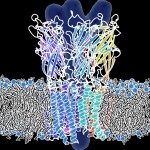Lien vers Pubmed [PMID] – 10884352
Lien vers HAL – Cliquez ici
Lien DOI – 10.1006/jmbi.2000.3854
J Mol Biol. 2000 Jul 14;300(3):563-74.
Sap1 is a DNA-binding protein involved in controlling the mating type switch in fission yeast Schizosaccharomyces pombe. In the absence of any significant sequence similarity with any structurally known protein, a variety of biophysical techniques has been used to probe the solution low-resolution structure of the sap1 protein. First, sap1 is demonstrated to be an unusually elongated dimer in solution by measuring the translational diffusion coefficient with two independent techniques: dynamic light-scattering and ultracentrifugation. Second, sequence analysis revealed the existence of a long coiled-coil region, which is responsible for dimerization. The length of the predicted coiled-coil matches estimates drawn from the hydrodynamic experimental behaviour of the molecule. In addition, the same measurements done on a shorter construct with a coiled-coil region shortened by roughly one-half confirmed the localization of the long coiled-coil region. A crude T-shape model incorporating all these information was built. Third, small-angle X-ray scattering (SAXS) of the free molecule provided additional evidence for the model. In particular, the P(r) curve strikingly demonstrates the existence of long intramolecular distances. Using a novel 3D reconstruction algorithm, a low resolution 3D model of the protein has been independently constructed that matches the SAXS experimental data. It also fits the translation diffusion coefficients measurements and agrees with the first T-shaped model. This low-resolution model has clearly biologically relevant new functional implications, suggesting that sap1 is a bifunctional protein, with the two active sites being separated by as much as 120 A; a tetrapeptide repeated four times at the C terminus of the molecule is postulated to be of utmost functional importance.

